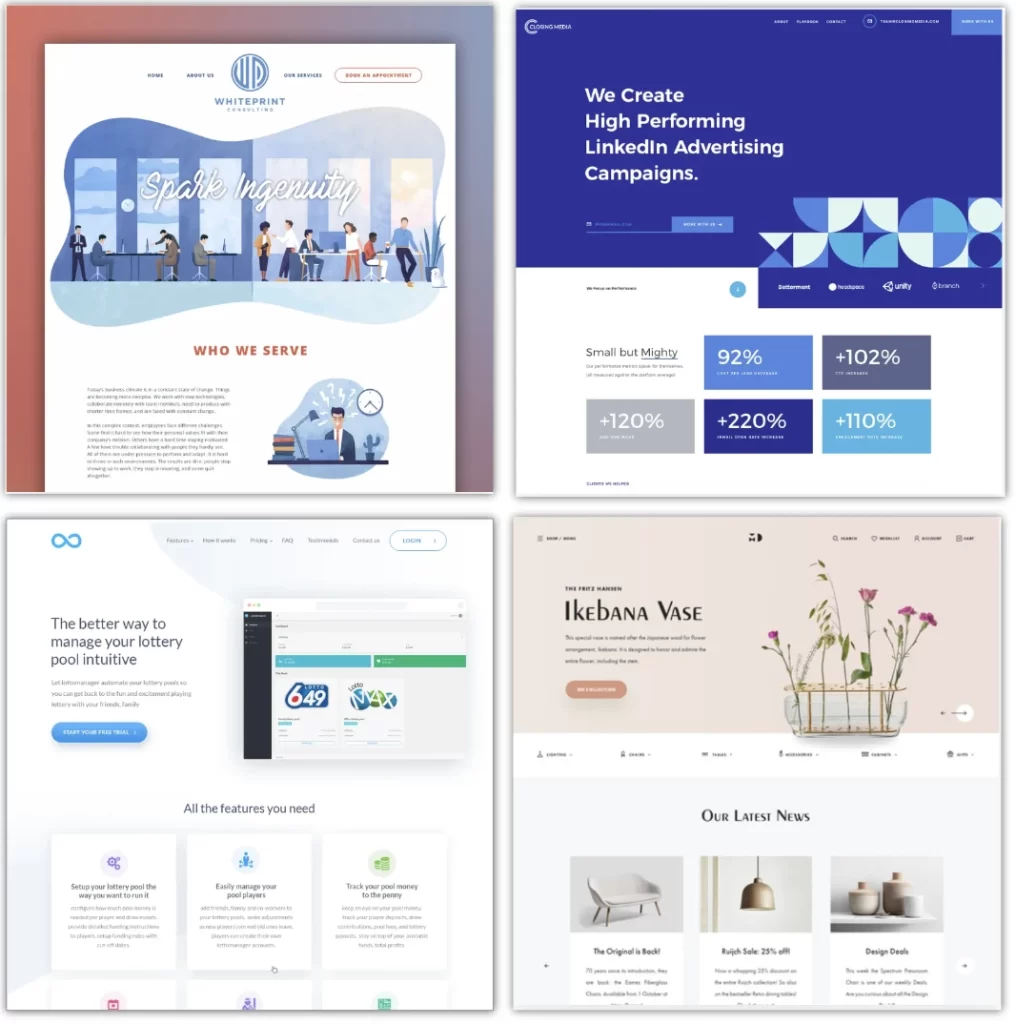How to Make a Great Business Homepage: Must-Have Elements for Success
Updated on September 10, 2025 by Tim Donahue
Table of Contents
- Hero Section
- Minimalist Design
- Breathing Room and Alignment
- Contact Information and Phone Number
- Essential Pages
- Product Grid for Ecommerce Sites
- Loading Speed Optimization
- Mobile Responsiveness
- Competitive Design Quality
- Clear Value Proposition
- Professional Web Development
- Ongoing Maintenance and Fresh Content
1. The Hero Section: Capturing Attention Instantly
The hero section is the first thing visitors will see when they land on your homepage. It sets the tone for your brand and communicates the most crucial aspects of your business. This section is essential when learning how to make a business website because it needs to be impactful.
Key Elements of a Hero Section:
- Hero Title in H1 Tags: The most critical text on the page, your H1 title should be bold, clear, and informative. This is a necessary element on a homepage to let visitors know what you do right away.
- Subtitle in H2 Tags: Provide more details under the title, using H2 tags. For example, you might add a short explanation of what makes your product or service unique.
- High-Quality Visuals: Images or videos should complement your messaging. Ensure they are high-quality and relevant to your business.
- Calls to Action (CTAs): Include a prominent button encouraging the user to take action, such as “Shop Now” or “Contact Us.” This is one of the most necessary elements on a homepage to drive engagement.
Here’s an image example of a minimalist Hero Section for your inspiration:

2. Minimalist Website Design: Keeping It Clean
When thinking about how to make a business website, simplicity is key. Minimalist design helps direct your visitors’ attention to the essential elements without distracting them.
Tips for a Minimalist Design:
- Use a Limited Color Palette: Stick to three colors maximum, plus neutral shades like white, gray, and black. This helps maintain a professional look.
- Font Selection: Use two or three fonts to keep the design clean. Too many fonts can overwhelm your visitors and detract from readability.
- White Space: Create ample white space around text and images. This gives the site a more organized feel and helps draw attention to your CTAs.

3. Breathing Room and Alignment: Make Your Page Easy to Read
If your homepage feels cluttered, visitors may leave before exploring your site. To avoid this, it’s important to include breathing room between elements. This ensures a smoother, more pleasant user experience for your website homepage – and gives them the information they are looking for quickly.
How to Achieve This:
- Side Gutter Space: Keep clear margins on both sides of the page.
- Spacing Between Elements: Use enough space between sections to prevent clutter and improve readability.
4. Visible Contact Information and Phone Number
In many industries, having a phone number or contact option visible on your homepage builds trust. Offering potential customers an easy way to get in touch is a necessary element on a homepage.
Tips for Contact Information:
- Place Phone Number Prominently: Display it in the header or hero section, so it’s visible as soon as visitors land on the page. Allow texting if you can.
- Offer Free Consultations: This can be a great call-to-action, encouraging visitors to connect with your business without feeling pressured.
5. Essential Pages: Beyond the Homepage
A great homepage is just the start of your website’s user journey. While building your homepage, you must also consider linking to other necessary pages that provide more detailed information.
Pages to Include:
- About Us: Share your story, mission, and values. Visitors want to know who they’re doing business with.
- Products/Services: This is a critical section for showcasing your offerings. Make it easy to navigate and informative.
- Contact: While you may have contact details on your homepage, a dedicated contact page gives visitors more options, such as filling out a form or sending an email.
6. Product Grid for Ecommerce Sites
If you are selling things and run an online store/ecommerce site, you need to make sure users know they can buy products – the way to do this is by showing them a product grid before they scroll very far.

7. Speed Matters: Optimizing Your Homepage Load Time
Visitors have no patience for slow websites. A homepage that takes too long to load will drive people away before they even see your content. Optimizing your website and homepage means making sure you use small data size images and code so that your pages load as quickly as possible. Ensuring a fast loading time is a necessary element on a homepage because studies show users often leave your page if it takes more than 3-4 seconds to load.
You can use Google’s Page Speed Insights tool to see if your page needs help or if it loads fast enough.
How to Improve Speed:
- Optimize Images: Use compressed, web-friendly formats to avoid long load times. Free tools like TinyPNG can help.
- Choose Fast Hosting: Pick a hosting provider with a reputation for speed, which is especially important for e-commerce sites.
8. Mobile Responsiveness: Don’t Lose Mobile Traffic
It’s no secret that more people browse the web on mobile devices than ever before. Your homepage must be mobile-friendly to succeed. When learning how to make a business website, ensuring responsive design is a crucial step.
Key Features for Mobile:
- Flexible Layouts: Ensure that the layout adapts to different screen sizes, providing a seamless user experience.
- Touch-Friendly Navigation: Buttons and links should be easy to tap, and text should be legible without zooming.
9. Competitive Quality: Measure Up Against Competitors
To make sure your homepage stands out, compare it with your competitors. What are they doing well, and how can you improve upon their designs?
Competitive Elements to Consider:
- Industry Norms: Understand the design standards in your industry and follow them while adding your unique touch.
- Color Schemes: Choose colors that fit your brand and industry. For example, a luxury brand should opt for rich, sophisticated hues like deep blues or golds, avoiding pastels.
10. Clear Value Proposition: Why Choose You?
A strong value proposition is one of the most necessary elements on a homepage. It’s the statement that explains to visitors why they should choose your business over a competitor’s. This is your chance to shine!
Crafting Your Value Proposition:
- Solve a Problem: Explain how your product or service meets your customer’s needs.
- Highlight Your Uniqueness: Focus on what sets you apart, whether it’s your exceptional customer service, innovative products, or competitive pricing.
11. Professional Web Development: When to Hire Help
While many new business founders take the DIY approach when learning how to make a business website, there are times when professional help is worth the investment.
Why Hire a Professional Developer:
- Better Features: Professional developers can create custom features like dynamic content or animations that may be difficult to build yourself.
- Improved SEO: Developers are also skilled at optimizing websites for search engines, ensuring that your business is more likely to be found by potential customers.
12. Ongoing Maintenance and Fresh Content
Launching your homepage is just the beginning. To maintain success, you must keep it up-to-date with fresh content and perform regular technical maintenance.
How to Maintain Your Website:
- Security Updates: Ensure that your site remains secure by keeping all plugins and software updated.
- Content Updates: Regularly refresh your content to keep visitors engaged and improve your SEO rankings.
Conclusion
Creating a strong homepage is essential to the success of your website. By incorporating these necessary elements on a homepage, you’ll provide an excellent user experience, keep visitors engaged, and increase your chances of converting them into loyal customers. Knowing how to make a business website that reflects your brand’s values and meets users’ needs is the foundation of your online success.
With the steps outlined in this guide, you’re well on your way to building a homepage that not only looks great but performs well, too!
